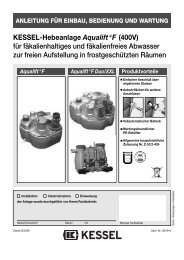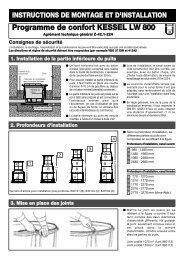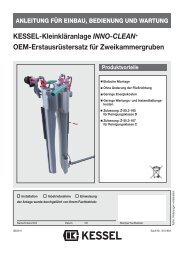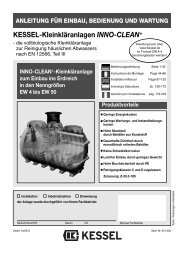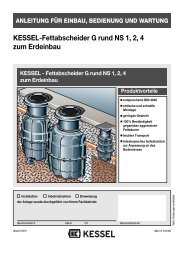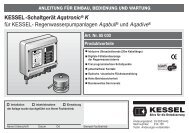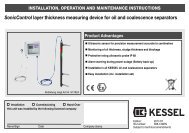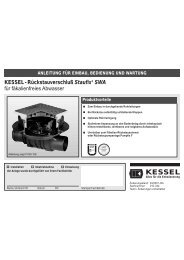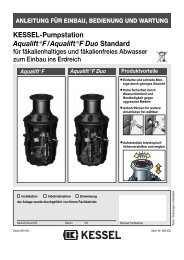KESSEL-Kleinkläranlagen INNO-CLEAN® - Kessel Design
KESSEL-Kleinkläranlagen INNO-CLEAN® - Kessel Design
KESSEL-Kleinkläranlagen INNO-CLEAN® - Kessel Design
Create successful ePaper yourself
Turn your PDF publications into a flip-book with our unique Google optimized e-Paper software.
7. Maintenance<br />
7.1 Maintenance Preliminary sedimentation + aeration<br />
Note: Please find out who is responsible for the maintenance<br />
of small sewage treatment plants in your area.<br />
For maintenance purposes, work and inspections must be<br />
carried out by the service staff at intervals of approx. 6<br />
months (at least twice every year). The plant components inside<br />
the tank are easy to maintain. The examination results<br />
of the purified sewage are requested by the Lower Water<br />
Authority as proof of the purification performance (operations<br />
diary).<br />
We recommend to at least carry out the following tasks:<br />
• Inspection of the operations diary for regular entry of the<br />
operating times.<br />
• Checking the plant's state of repair, e.g.: accessibility, ventilation,<br />
screw connections, hoses.<br />
• Checking the free mobility of the floater.<br />
• Function check of all mechanical, electrical and other plant<br />
parts, in particular of the compressor and ventilation facilities.<br />
• Function check of the alarm function and control for possible<br />
faults or incidents.<br />
• Inspection of the air syphons (clear water, feeding and<br />
sludge syphon) for clogging. For this purpose it may be necessary<br />
to remove and clean the air syphons. To do so,<br />
unlock the snap closing on the syphon and pull out the<br />
grey air hose. Afterwards open the red locking lever and<br />
pull the air syphon out of the purification tower. Thus, the<br />
syphon incl. the inside hose can be cleaned of any dirt. Afterwards<br />
return the lever into the appropriate position and<br />
connect it correctly.<br />
• If an inadequate ventilation pattern makes it necessary to<br />
clean or replace the aerator spark plug, the latter can be<br />
removed via the integrated guide rail on the purification<br />
tower. The aerator spark plug is located underneath the<br />
outlet pipe on the bottom of the tank. Pull out the aerator<br />
spark plug by means of the pertinent air hose. When inserting<br />
the aerator spark plug, pay attention that the integrated<br />
guide claw is placed back into the guide rail on the<br />
purification tower. The aerator spark plug must be let down<br />
to the bottom of the tank.<br />
• Performance of general cleaning work such as e.g.: removal<br />
of deposits, removal of foreign matter.<br />
• Pay attention that the floating switch is clean and free floating.<br />
• Setting optimum performance data (see table page 29) e.g.<br />
oxygen supply (~ 2 mg/l), sludge volume (300 - 500 ml/l).<br />
• Determining the sludge level inside the sludge storage and<br />
possibly initiating the sludge removal.<br />
The maintenance that is carried out must be recorded in the<br />
operations diary.<br />
<br />
<br />
<br />
<br />
<br />
<br />
<br />
<br />
<br />
Sampling vessel<br />
Clear water syphon<br />
Feed syphon<br />
Sludge syphon<br />
Discharge pipe<br />
Snap closing<br />
Locking lever<br />
Valve block<br />
Floating switch<br />
113



